Both Monopolies And Competitive Firms
Topic 8: Imperfect Competition
8.4 Monopolistic Contest
Learning Objectives
By the finish of this department, you volition exist able to:
- Explicate the significance of differentiated products
- Depict how a monopolistic competitor chooses price and quantity
- Discuss entry, leave, and efficiency every bit they pertain to monopolistic competition
- Analyze how advertising tin can impact monopolistic competition
Nosotros have now explored the two sides of the spectrum. In perfect competition, nosotros assume identical products, and in a monopoly, we assume only one product is available.
Monopolistic contest lies in-between. It involves many firms competing confronting each other, but selling products that are distinctive in some way. Examples include stores that sell dissimilar styles of clothing, restaurants or grocery stores that sell dissimilar kinds of nutrient and fifty-fifty products similar golf balls or beer that may be at least somewhat like just differ in public perception because of advertising and brand names. Firms producing such products must likewise compete with other styles, flavours and make names. The term "monopolistic competition" captures this mixture of mini-monopoly and tough competition.
Who invented the theory of imperfect competition?
The theory of imperfect competition was developed past two economists independently but simultaneously in 1933. The commencement was Edward Chamberlin of Harvard University who publishedThe Economics of Monopolistic Competition. The second was Joan Robinson of Cambridge University who publishedThe Economics of Imperfect Contest. Robinson subsequently became interested in macroeconomics where she became a prominent Keynesian, and later a mail-Keynesian economist.
Differentiated Products
A business firm can try to brand its products dissimilar from those of its competitors in several ways: physical aspects of the product, selling location, intangible aspects of the production, and perceptions of the product. Products that are distinctive in one of these four ways are chosendifferentiated products.
Concrete aspects of a product include all the phrases you hear in advertisements: such as an unbreakable bottle, nonstick surface, freezer-to-microwave, not-compress, extra spicy, newly redesigned for your comfort. The location of a firm tin as well create a difference between producers. For example, a gas station located at a busy intersection tin probably sell more than gas than one located on a small side-road. A supplier to an automobile manufacturer may find that it is advantageous to locate well-nigh the motorcar manufactory.
Intangible aspects can differentiate a product, too. Some intangible aspects may be promises like a guarantee of satisfaction or coin dorsum, a reputation for high-quality services like free delivery, or a loan to purchase the product. Finally,product perception may occur in the minds of the buyers. For example, many people could non tell the deviation in taste between common varieties of beer or cigarettes if they were blindfolded, simply because of past habits and advertizement, they have strong preferences for sure brands. Advertisement can play a role in shaping these intangible preferences.
The concept of differentiated products is closely related to the degree of diverseness that is available. If everyone in the economy wore but bluish jeans, ate merely white bread, and drank only tap water, then the markets for clothing, nutrient, and potable would be much closer to perfectly competitive. The variety of styles, flavors, locations, and characteristics creates product differentiation and monopolistic competition.
Perceived Demand for a Monopolistic Competitor
A monopolistically competitive firm faces a demand for its appurtenances that is between monopoly and perfect competition. Figure 8.4a offers a reminder that the demand curve as faced by a perfectly competitive firm is perfectly rubberband or flat, because the perfectly competitive house can sell any quantity it wishes at the prevailing market place price. In dissimilarity, the demand curve, equally faced by a monopolist, is the market demand curve, since a monopolist is the only house in the market, and hence is downward sloping.
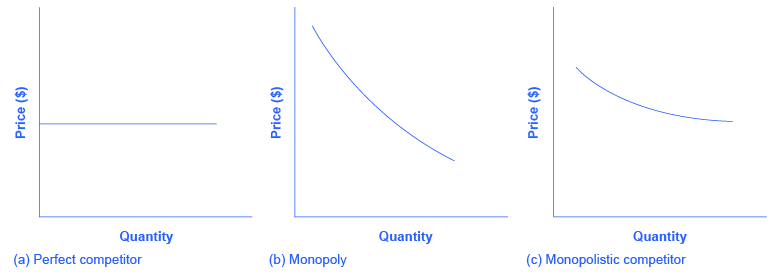
The need curve as faced by a monopolistic competitor is not flat, but rather downward-sloping, meaning that the monopolistic competitor, similar the monopoly, tin raise its price without losing all of its customers or lower its toll and gain more customers. Since in that location are substitutes, the demand curve for a monopolistically competitive house is relatively more elastic than that of a monopoly, where at that place are no close substitutes. If a monopolist raises its price, some consumers volition cull not to purchase its product—merely they will and so need to buy a completely different product. However, when a monopolistic competitor raises its toll, consumers tin choose to buy a similar product from another business firm. If a monopolistic competitor raises its price, it volition not lose as many customers equally would a perfectly competitive house, but it will lose more than customers than a monopoly would.
At a glance, the need curves faced by a monopoly and monopolistic competitor await like—that is, they both slope down. Nonetheless, the underlying economic meaning of these need curves is dissimilar because a monopolist faces the marketplace demand curve and a monopolistic competitor does not.
Cellular Contest

Call up that monopolistic contest refers to an industry that has more than a few firms that each offer a distinguished product. The Canadian cellular industry is 1 such marketplace. With a history dating dorsum as far as Alexander Graham Bell's invention of the telephone in 1876, the Canadian cellular industry now has a number of large firms including Rogers, Telus, and Bell. What about Fido, Koodo, and Virgin Mobile? They are owned by Rogers, Telus, and Bell, respectively. While this market has some similarities to an Oligopoly (which we volition non explore in this course), information technology is oft classified as a monopolistic competition.
Consider what you would exercise if your monthly cell telephone bill increased past $ii. Would you switch to another company? Likely not. This ways that the cellular market is certainly not perfectly competitive as cell telephone companies accept some ability to change prices. Therefore, the need faced past each of the cellular companies will be more elastic than market place demand, but not perfectly elastic. Allow's explore how these monopolistic competitive firms fix prices.
How a Monopolistic Competitor Chooses Price and Quantity
To explore monopolistic competition, allow'southward consider Rogers, i of the Cellular companies in the marketplace. Rogers faces a downward sloping demand curve and has ATC and MC curves similar to the ones nosotros have seen earlier.
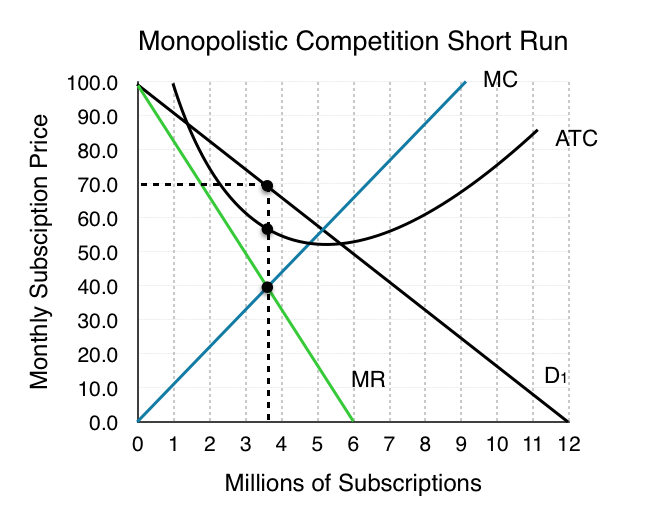
The monopolistically competitive firm decides on its profit-maximizing quantity and price similar to the way that a monopolist does. Since they confront a downward sloping demand bend, the same considerations about how elasticity affects acquirement are relevant, and the firm will maximize profits where MR = MC when P > MR.
Pace one.Rogers determines its profit-maximizing level of output. This will occur where MR = MC. Two situations are possible:
- If the house is producing at a quantity of output where marginal acquirement exceeds marginal cost, and so the firm should go along expanding production, because each marginal unit is adding to profit past bringing in more revenue than price. In this way, the firm will produce upwards to the quantity where MR = MC.
- If the business firm is producing at a quantity where marginal costs exceed marginal acquirement, then each marginal unit of measurement is costing more than the revenue it brings in, and the firm will increment its profits by reducing the quantity of output until MR = MC.
In this example, MR and MC intersect when Rogers has 3.6 million subscribers.
Step two. Rogers decides what price to accuse. When the house has determined its profit-maximizing quantity of output, it will carry like a monopoly and accuse the maximum it can at the quantity. On the graph, this process can exist shown as a vertical line reaching up through the turn a profit-maximizing quantity until information technology hits the firm'due south perceived demand curve. For Rogers, this occurs at a cost of $70/calendar month.
Monopolistic Competitors and Entry
Consider the profits of Rogers at equilibrium quantity of 3.six million subscribers:
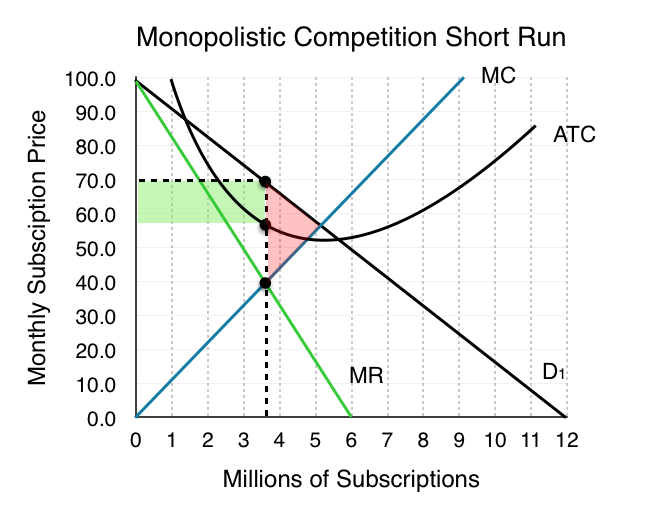
At a price of $lxx/month, ATC is simply $60 and Rogers' profit is $36 million. ($ten profit/subscriber) Notice that this market place creates a deadweight loss equal to the crimson area since the equilibrium quantity is less than what would occur in competitive equilibrium (5 million subscriptions).
Recollect that in monopolistic contest, there are few barriers to entry. Since Rogers is earning positive economical profits, other firms will be tempted to enter the market.
The entry of other firms into the same general market shifts the need curve faced by a monopolistically competitive business firm. As more than firms enter the market, the quantity demanded at a given cost for any particular firm volition decline, and the firm's perceived need curve volition shift to the left. As a firm's perceived demand curve shifts to the left, its marginal revenue curve will also shift to the left. The shift in marginal revenue will change the turn a profit-maximizing quantity that the firm chooses to produce since marginal revenue will then equal marginal toll at a lower quantity.
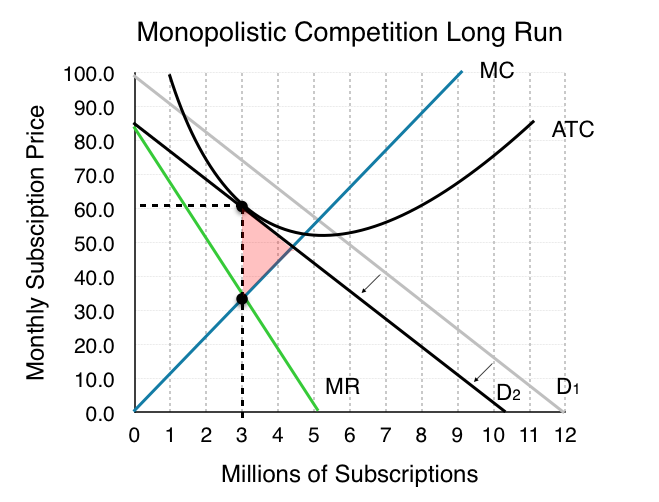
When will this shifting cease? When profits are 0. As long as P > ATC firms will continue to enter the marketplace, and demand will go along to shift in. As shown in Figure viii.4d, this occurs when P = ATC and MR = MC. This specific point happens when Demand is tangent to ATC, because only when this is true can P = ATC, given that ATC is downward sloping (recall that the MC bend passes through ATC at the minimum signal of ATC, and note that the minimum betoken of ATC is at a quantity higher than that produced by the monopolistically competitive house).
What about the social surplus? Although profits are now 0, a deadweight loss persists. This is considering, dissimilar perfect competition, P > MR, which besides means that P > MC. Since consumers' willingness to pay is greater that the marginal price of the firm, market place failure continues. Remember that a key reason for this is the firms' inability to charge more that one toll. Notice too that ATC is not at a minimum. This is the price the market pays for variety since the aggregate market place does non ensure the about efficient production when there is slight differentiation in products.
The Benefits of Diversity and Product Differentiation
Even though monopolistic competition does not provide efficiency, it does have benefits of its ain. Product differentiation is based on multifariousness and innovation. Many people would prefer to live in an economy with many kinds of clothes, foods, and car styles; not in a earth of perfect contest where anybody will always wear blue jeans and white shirts, swallow only spaghetti with evidently red sauce, and drive an identical model of automobile. Many people would prefer to live in an economy where firms are struggling to figure out means of attracting customers by methods like friendlier service, gratis delivery, guarantees of quality, variations on existing products, and a amend shopping experience.
Economists have struggled, with merely partial success, to address the question of whether a market-oriented economy produces the optimal amount of variety. Critics of market-oriented economies argue that society does non really need dozens of unlike able-bodied shoes or breakfast cereals or automobiles. They argue that much of the cost of creating such a high degree of product differentiation, so of advertising and marketing this differentiation, is socially wasteful—that is, most people would be simply as happy with a smaller range ofdifferentiated products produced and sold at a lower cost. Defenders of a market-oriented economy respond that if people do not want to buy differentiated products or highly advertised brand names, no one is forcing them to do so. Moreover, they argue that consumers benefit substantially when firms seek short-term profits past providing differentiated products. This controversy may never be fully resolved, in function considering deciding on the optimal amount of variety is very difficult, and in part considering the two sides oft place unlike values on what variety ways for consumers.
How does advertising impact monopolistic competition?

The Canadian economy spent almost $12.22 billion on advert in 2016, according to statista.com.
Advertising is all about explaining to people, or making people believe, that the products of ane firm are differentiated from the products of some other business firm. In the framework of monopolistic contest, there are ii ways to excogitate how advertisement works: either advertising causes a firm's perceived need bend to become more inelastic (that is, it causes the perceived demand bend to get steeper), or advertising causes demand for the firm's product to increase (that is, it causes the firm's perceived demand curve to shift to the right). In either example, a successful advertisement campaign may allow a business firm to sell either a greater quantity or to charge a higher price, or both, and thus increment its profits.
However, economists and business owners have also long suspected that much of the advertisement may simply offset other advertizement. Economist A. C. Pigou wrote the post-obit dorsum in 1920 in his volume,The Economics of Welfare:
It may happen that expenditures on advertisement fabricated by competing monopolists [that is, what nosotros at present call monopolistic competitors] will just neutralise one another, and get out the industrial position exactly as information technology would have been if neither had expended anything. For, clearly, if each of two rivals makes equal efforts to attract the favour of the public away from the other, the total result is the same as it would have been if neither had made any effort at all.
Summary
Monopolistic competition refers to a market where many firms sell differentiated products. Differentiated products can arise from characteristics of the good or service, location from which the production is sold, intangible aspects of the product, and perceptions of the product.
If the firms in a monopolistically competitive industry are earning economical profits, the industry volition attract entry until profits are driven downward to aught in the long run. If the firms in a monopolistically competitive manufacture are suffering economic losses, then the industry volition see an exit of firms until economic profits are driven up to zero in the long run.
A monopolistically competitive firm is not efficient considering it does not produce at the minimum of its average price curve or produce where P = MC. Thus, a monopolistically competitive firm volition tend to produce a lower quantity at a college cost and charge a college price than a perfectly competitive firm.
Monopolistically competitive industries do offer benefits to consumers in the class of greater variety and incentives for improved products and services. In that location is some controversy over whether a market-oriented economy generates likewise much diversity.
The following table summarizes the iii types of market structure we have examined. The fourth, oligopoly, is not in the scope of this course.
Market type | Description | MR v P | P v MC | LR Π | LR ATC | DWL |
| Perf. Comp. | Many sellers, identical goods, gratuitous entry in LR | MR = P | P = MC | Π = 0 | ATCLR = ATCMIN | No |
| Monopoly | Single seller, barriers to entry | MR < P | P > MC | Π > 0 | ATCLR > ATCMIN | Aye |
| Monopolistic Comp. | Many sellers, differentiated products, free entry in LR | MR < P | P > MC | Π = 0 | ATCLR > ATCMIN | Y |
Glossary
- Differentiated Products
- a production that is perceived by consumers every bit distinctive in some style
- Monopolistic Competition
- many firms competing to sell similar but differentiated products
Exercises 8.4
The following TWO questions refer to the diagram below, which illustrates the demand, marginal revenue, and relevant cost curves for a monopolistically competitive house.
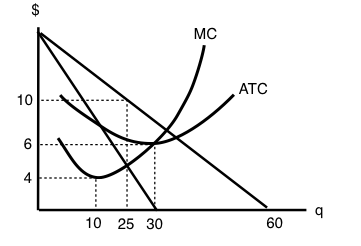
ane. How many units of output should this firm produce, in order to maximize profits?
a) 10.
b) 25.
c) thirty.
d) 60.
two. In the long run, what price will this firm charge for its output?
a) $10.
b) A price less than $10 and greater than $half dozen.
c) $half-dozen.
d) A price less than $6 and greater than $four.
The following 2 questions refer to the diagram below.
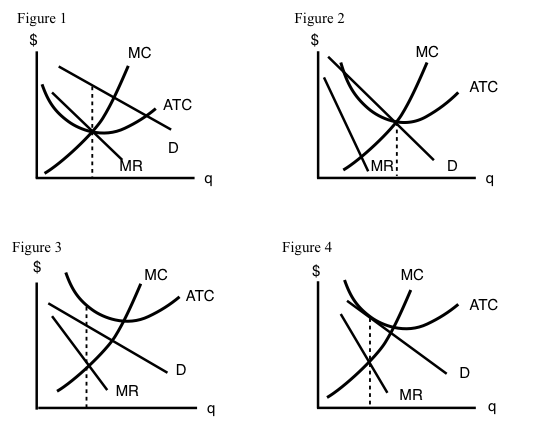
three. Which of the four diagrams illustrates a long run equilibrium for a monopolistically competitive firm?
a) Figure 1.
b) Figure 2.
c) Figure 4.
d) Figures 2 and 4.
4. Which of the four diagrams illustrates a monopolistically competitive house able to make positive economic profits in the short run?
a) Effigy one.
b) Figure 2.
c) Figures one and 2.
d) None of the above.
v. Which of the following statements virtually the comparison between monopolistic competition in the long run and monopoly in the long run is Imitation?
a) Marginal revenue is less than price for both monopoly and monopolistic competition.
b) Cost is greater than marginal cost for both monopoly and monopolistic competition.
c) Price is greater than average full cost for both monopoly and monopolistic competition.
d) Neither monopoly or monopolistic competition produce at the minimum signal of the average total cost curve.
half dozen. Which of the following statements near the comparison betwixt perfect competition and monopolistic competition is True?
I. Both perfectly competitive and monopolistically competitive firms produce where marginal revenue equals marginal cost.
II. Both perfectly competitive and monopolistically competitive firms produce where cost equals marginal price.
3. Both perfectly competitive and monopolistically industries are characterized by gratis entry and zero profits in the long run.
a) I only.
b) I and Three simply.
c) I and 2 only.
d) I, Two and III.
Both Monopolies And Competitive Firms,
Source: https://pressbooks.bccampus.ca/uvicecon103/chapter/8-3-monopolistic-competition/
Posted by: noeoulthe.blogspot.com


0 Response to "Both Monopolies And Competitive Firms"
Post a Comment